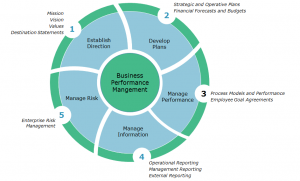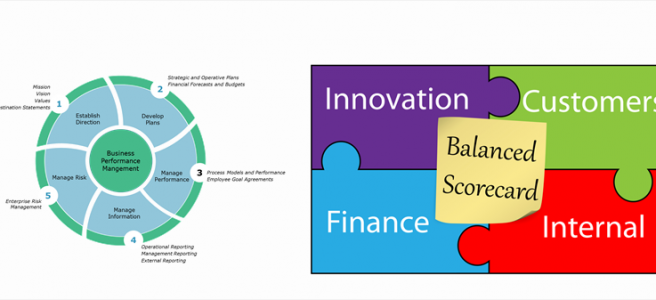One of the benefits of using a framework for structuring our thinking is that this can help identify aspects we may have missed. The Business Performance Management framework is a popular, high-level representation of an organisation and consists of five processes:
- Establish Direction: This process results in a Mission and Vision statement, a description of the organisational Core Values and, possibly, a set of Destination Statements. Destination statements are descriptions of what the Vision might look like as seen from the eyes of the stakeholders.
- Develop Plans: The outputs of this process are the Strategic and Operative Plans and their financial representation, Financial Forecasts and Budgets. The Strategic Plan includes a set of strategic objectives intended to realise the Destination Statements and a set of initiatives, metrics and targets. The Operative Plan also includes a set of initiatives, metrics and targets, but over a shorter timeframe such as one year.
- Manage Performance: This process includes the setup needed for, and management of, the performance of processes and people.
- Manage Information: This process covers reporting on operational performance, analytical management reporting and external and internal financial reporting.
- Manage Risk: This process helps maintain an overview of business risk to achieving the strategic and operative plans.

Figure: The Business Performance Management Framework (BPM)
There is nothing special about the BPM framework; it is one of several available in the public domain. But things get interesting when we try to overlay the Balanced Scorecard (BSc) on the BPM framework to see how they compare.
The first generation BSc covers only two of the processes: Develop Plans and Manage Information. Plans include a set of objectives, metrics and targets and this version of the BSC is restricted to showing how the organisation is tracking against the targets. The second generation BSc goes a bit deeper into the Develop Plans process because it also lists the initiatives intended to achieve the objectives, thus making it easier to assess whether the initiatives are sufficient to deliver the planned outcomes. The third generation BSc includes a strategy map. If the organisation uses the BSc as part of its planning, the Strategic Plan is likely to include a depiction of the strategy map. So there are number of areas of overlap between the BPM and BSc frameworks.
Now let’s look at some of the gaps between the two frameworks by considering each of the processes of the BPM framework.
- The BSc framework doesn’t include a construct for the Vision or Mission, but assumes that the organisation already has an articulated statement of company direction.
- The strategy map is a good way to test the quality of a Strategic Plan, but an organisation can come up with high-quality Strategic Plan even if doesn’t use the BSc framework. The strategy map, however, because of its focus on strategic, generally long-term, cause-effect relationships, may not help at all in the development or validation of an Operative Plan. Strategic Plans are typically at the organisational level, but one can have an Operative Plan at the organisational or departmental or at any level for that matter. The BSc framework focuses on a single organisational level and alignment of scorecards across levels can be a challenge.
- The processes Manage Performance and Manage Information are core strengths of the BSc framework.
- It is not easy to represent the alignment between risk and appetite for risk using the BSc.
In this post we have compared, albeit at very high-level, the BPM and BSc frameworks to explore their relative strengths and weaknesses. In the next post we’ll consider another framework, one that has a rather different perspective on organisations.
If you are interested in learning more about organisational alignment, how misalignment can arise and what you can do about it join the community. Along the way, I’ll share some tools and frameworks that might help you improve alignment in your organisation.

